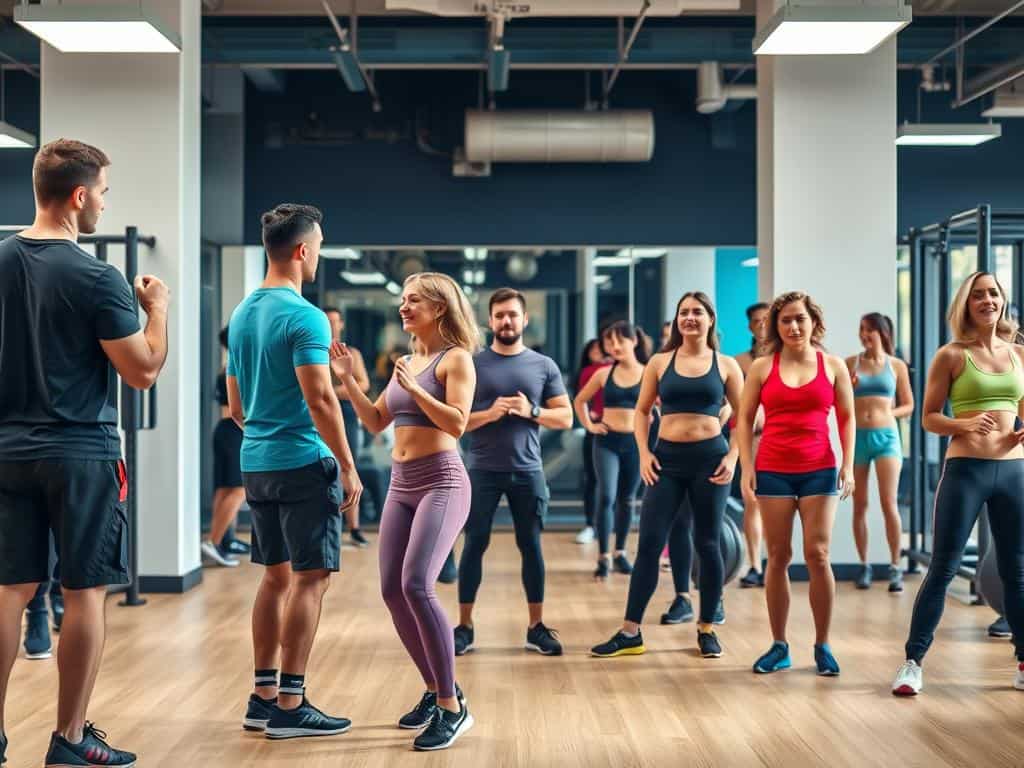Did you know fusing functional training into your workouts can really drop your injury chances? This method aims to boost your daily task performance. It does this by using movements like squatting, lifting, and bending.
By working various muscle groups, functional fitness does more than make you strong and flexible. It also betters balance and overall stability. I’ve seen the benefits firsthand.
What’s great is anyone can try functional fitness. It often needs little to no gear, fitting different skills and aims. It has made me value how I perform over how I look. This perspective promotes a life lived healthier and with fewer injuries. No matter if you’re older aiming to stay active or healing from an injury, this fitness is key.
Key Takeaways
- Functional fitness significantly reduces injury risk.
- It benefits individuals of all fitness levels, ages, and goals.
- Core stability exercises enhance balance and coordination.
- Bodyweight squats can improve mobility in older adults.
- Regular functional exercises can ease joint and muscle pain.
- This type of training contributes to overall athletic performance.
What is Functional Fitness?
In today’s fast-paced world, understanding functional fitness becomes important for improving daily life activities. This approach helps develop strength, balance, and coordination. It does so through exercises that mimic real-life movements. Unlike traditional gym workouts, functional fitness prepares us for everyday tasks.
Understanding Functional Fitness Training
Functional fitness training uses various exercises to improve core stability and mobility. It includes movements like walking, lifting, and bending. These are crucial for performing daily activities. Engaging in such training makes climbing stairs or carrying groceries easier. Resistance exercises boost core strength, creating muscle memory for these vital movements.
The Role of Movement Training
Movement training is key in functional fitness. It promotes proper form and technique, enhancing balance and coordination. By doing exercises that use many joints and muscle groups, daily tasks become less tiring. Exercises like lunges with overhead presses or deadlifts teach the body to work together. This leads to not just stronger muscles but also a body that’s ready for daily challenges.
Benefits of Functional Fitness
Functional fitness offers many advantages, making our daily lives better. It focuses on training that helps with everyday activities, increasing our physical strength, flexibility, and balance.
Enhancing Strength, Flexibility, and Balance
Functional fitness is great for boosting strength, flexibility, and balance all at once. It involves compound movements that work several muscle groups, building muscle useful in daily tasks. For example, exercises like squats and lunges strengthen your lower body. They also improve your coordination and stability, essential for day-to-day activities.
People at any fitness level can adapt functional fitness routines to their needs. Whether you’re just starting or are a pro athlete, you’ll see gains in strength, flexibility, and balance.
Core Stability and Injury Prevention
Having a strong core is key to functional fitness. It helps you maintain good posture and reduces the chance of back pain. This can make a big difference in how well we move.
Functional fitness also aims to prevent injuries by helping the body manage physical stress better. In my experience, practicing regularly has made me more aware of my body. This leads to better control over movements. Studies show that functional fitness lowers the risk of injuries, especially in older adults. It boosts muscle strength and improves how well they function daily.
This training puts a big focus on core stability. It ensures people carry out their daily activities with more confidence and less risk of accidents.

Functional Fitness: Get Started Today
Starting my path to functional fitness is exciting but might feel unsure at first. It’s crucial to find the best way to start. I can begin with basic bodyweight exercises.
These basic moves will make me more confident. Then I can add resistance with weights or bands. I have many options, like yoga, Pilates, and group classes. These offer knowledge and support from others.
The Best Place to Begin Your Functional Training Journey
Choosing the right place is key for success in functional training. Joining classes at gyms that focus on functional fitness is a good move. I learn from trainers who know their stuff.
These programs are great for all levels. They focus on safe, effective techniques. They also help me move better in my daily life. Doing functional fitness improves my strength, balance, and flexibility. It’s good for my health.
Incorporating Functional Exercises into Your Routine
Adding functional exercises to my routine is important. Squats, lunges, and deadlifts are great exercises I can do often. They work several muscles and help with daily tasks.
These exercises keep me agile and lower injury risks. Talking with expert trainers helps me tailor my workouts. This way, I get stronger in both strength and flexibility. This makes daily chores easier.
Conclusion
Functional fitness has truly changed my life. It has made daily tasks easier and improved my strength. Now, I handle life’s physical demands better and enjoy my days more.
My strength, flexibility, and balance have all gotten better. I also face fewer injury risks. Core exercises have improved my posture and made me stronger.
Functional fitness focuses on the whole body, not just looks. It keeps me active and healthy. Making it a part of my routine shows I’m dedicated to a good life at all stages.



